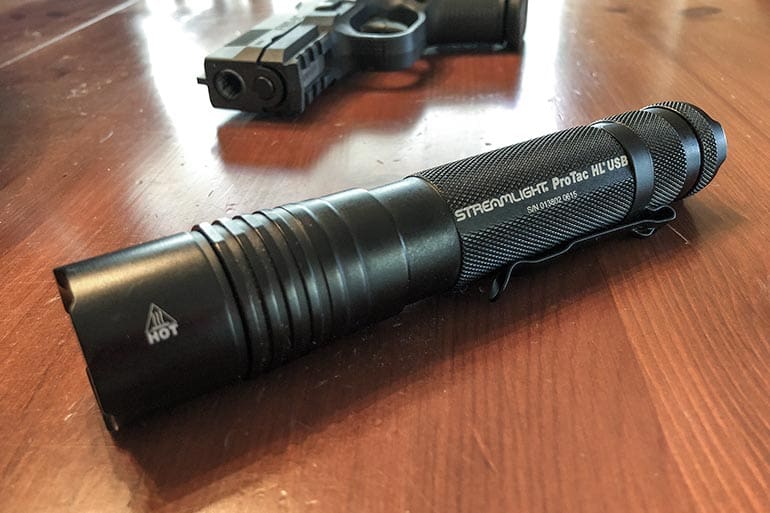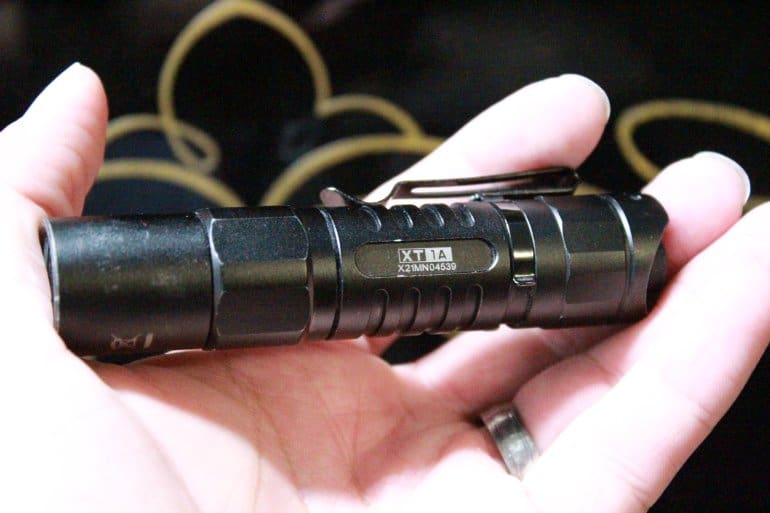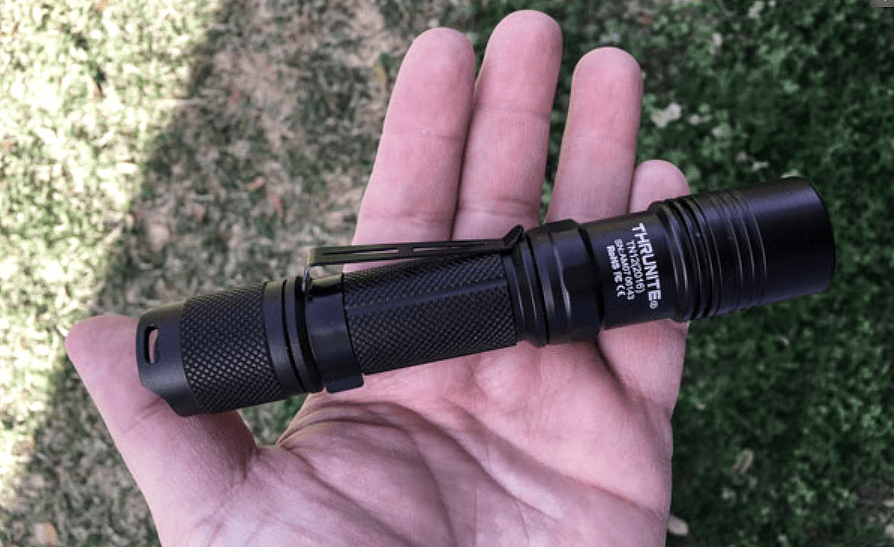At a recent class, a student asked me about using a flashlight for self-defense while carrying concealed. My first response: are you carrying a good handheld light? My second: do you understand its importance?
Let There Be Light!
Consider the general utility of a good handheld light for a moment; how you can use it to find lost items inside your car, light-up your trip to the trash cans, look down your sick kid’s throat, etc. And unlike your firearms, “gun-free zones” don’t apply to flashlights. You can take one almost anyplace.
Now consider the possibility of using a flashlight as an impact weapon. They’re generally extremely sturdy metal rods. Some also have a crenulated bezel to increase the damage a strike can inflict on an attacker. Along with a knife, flashlights are an ideal everyday dual-purpose defensive tool.
When it comes to combining a flashlight with armed defense, know this: even though it’s hard to find yourself in a completely dark environment, it’s easy to find yourself someplace where you can’t identify a potential threat with 100 percent certainty. Is that someone coming at you or someone trying to move by you? There’s a big difference.
Identify the Unknown ASAP
I don’t see any compelling reason you can’t pull your handheld light out — even during daytime conditions — when things just don’t feel right.

When you become aware of a potential threat that you can’t initially decipher, you can use your flashlight to scan and, potentially thwart without having it in a “shoot ready” position. In fact, during the initial moments of an unknown encounter, it may be prudent to hold a light in your hand long before you can justify having a gun in your hand.
Light Up Their Life
When you decide to illuminate the unknown, you must do so so you can positively identify friend from foe. Your technique should illuminate the unknown with enough light to see what you need to see to choose whether or not to employ lethal force.
Start big. Light up their center mass, so you can get a general picture of who’s ahead; where they’re going, how fast they’re moving, how they’re dressed, whether or not they’re alone, and their body posture. Then aim your beam at their hands, scanning for a weapon. If the unknown person turns out to be harmless, finish with an apology for temporarily blinding them. No harm, no foul.
If the situation becomes a worst case scenario, transition to your draw stroke…while maintaining the tactical advantage provided by a blinding, high intensity light. Your one-hand clearance method better be legit.
The question then becomes, do you keep the light trained on the bad guy or extinguish it?
There’s no one “right” answer. That decision depends on what you saw in the first few moments that convinced you to draw your handgun. Factors like distance, action and whether you can move and move to a better location help determine the right course of action. The bottom line: the situation will dictate.

There’s plenty more to discuss about flashlights and self-defense. For now, remember that a good handheld light should be in everyone’s load out. It could well be the difference between life and death.
The problem with low light defensive techniques: they’re based around shooting, not searching. Most gun owners fail to put a significant amount of time and resources into learning how to search in the dark.
While it’s not rocket science, there’s still a great deal to be learned. One of the most important: getting comfortable working in the dark.
Most of the time we’re training in ideal or pristine conditions. It’s hard to gain the proficiency and comfort necessary to work well at night. The key here is, of course, practicing in low-light conditions.
Some ranges offer classes in low-light shooting. Take those courses. Many, if not most attacks occur at night. It’s also possible to practice low-light defensive techniques in any safe, secure environment with a [triple-checked] empty gun.

As for searching, I prefer to use a two-handed technique. It allows me to direct the light to any location to identify threats or exploit a tactical advantage (by blinding the attacker). I can employ the full capability of the projected light, angling the beam to splash light into hard-to-reach areas.
If you locate an unknown and identify it to be a foe deploying lethal force, shooting should be a seamless transition. Using a technique that stabilizes the light while allowing you to engage with effective fire is key.
Holding the light at “high index” is the best method I’ve found to enable an efficient draw. I position the light near my jawline (see above) to illuminate both the target area and my sight system. While you will may be called to employ lethal force using your strong hand only, you can make that choice because of a superior search technique.
Note: this scenario highlights the mission-critical importance of mastering an efficient one-handed draw and one-handed shooting.
Weapon-Mounted Lights
As for weapon-mounted lights . . .
Some students tell me they don’t need a handheld light. Their weapon-mounted light would get the job done during a low-light defensive gun use.
Wrong answer.
Before you can use the weapon-mounted light you have to be justified in deploying your firearm. In other words, you have to identify the threat before you draw your gun and use your weapon-mounted light. If you’re wrong, you could face a brandishing charge and/or convince someone else that you’re the threat.
That’s the main reason to have a handheld light as your primary search tool. But it’s also true that you’ll find your light a useful device for everyday chores.
Searching in low-light conditions with a handheld light is a legal early warning system that also allows effective freedom of movement. Many times, the outcome of a defensive gun use doesn’t come down to who’s the best shot, but who saw whom first.
Jeff Gonzales is a former US. Navy SEAL and preeminent weapons and tactics instructor. He brings his Naval Special Warfare mindset, operational success and lessons learned to the world at large. He is the president of Trident Concepts in Austin, Texas.





“Wrong answer.”
Here’s another reason- if your eyes are adjusted to the dark, a bright weapons mounted light will absolutely kill your night vision. Not such a big deal if you’ve identified your problem, but really big deal if you’re searching for your problem and your plan was to blink your light on and off.
I favor a handheld with a “hi/low” setting for snooping around, and a weapon light for illuminating the target. Best of both worlds.
Finding a flashlight like that is more of a chore than it should be: I don’t need or want 8 brightness settings and a strobe function to turn on randomly at the worst possible moment (which is all possible moments, strobes are such mall ninja bs).
I want adrenaline dump simple controls with two settings that are easily discernible; “where is that thing I dropped?” and “who the hell are you?”
While a different application, I loved the strobe while stopping , traffic . 30 years working for the FD, I’ve stopped tons of cars with tons of different lights and I have to say the strobe feature always seemed to get their attention sooner .
Often times we’d have to back the rig out of a side street , on to a main road ,so stopping traffic prior to the rig being seen by the drivers was the norm , and a strobe was awesome .
+1 for the strobe feature, though I keep a separate handheld light with the option in my vehicle for such emergencies. It has both strobe and “SOS” flash options. But that’s for a vehicle emergency situation…I don’t want those features mucking up my gun lights.
They aren’t hard to find. https://www.surefire.com/products/illumination/flashlights/g2x-maxvision/
Exactly. I have an Olight PL Mini on my nightstand G17 because it not only fits nicely under the frame (it has a very small profile), but it puts out 400 lumens. That’s bright enough to illuminate a target, but not so much as to cause me to wince when turning it on in a dark hallway.
For normal investigations into “bumps in the night”, I also have a handheld flashlight on the nightstand. Set at a normal 600 lumens, but with a quick double-tap (no pun intended) of the power button, blasts at 3000 lumens to disorient an adversary. Or a raccoon.
In LA in the late 80’s, I found that a flashlight could be very useful for self defense. Specifically, a 5-D cell Maglight. If you grabbed that thing by the light/reflector housing and swung it like a club, it made quite an impression on someone who laid their hands on you.
Afterwards, you could tell Officer Friendly that you carry a flashlight on you, “just to be prepared.” When Officer Friendly asked you “Prepared for what?! you could say “When it gets dark…”
Add a look of innocent puzzlement when answering Officer Friendly’s questions for best effect.
I still have my 5 D cell MagLite I bought at a CostCo around 30 years ago. Still works great, lives in my vehicle.
Cops I knew back then had bigger, longer, heavier 5 D cell MagLites. That’s because they bought a weight that screwed on in place of the endcap. Made for a heck of a weighted club.
There’s a guy on YouTube who built a backpack laser cannon with a bunch of batteries and high power lasers for astronomy all built together for a common focal point. Sets targets on fire with it, it’s insane.
I’m thinking maybe that’s my next self defense light.
It does take more than 5 D cells though
Link to the laser cannon….I gotta see this….
I keep a 3 D cell maglite in my car. Would seem to be a heck of an attitude adjuster if necessary.
I eventually got rid of all my maglites but one, a 2 C cell variety, and then found a LED conversion for it, which is really great, I figure the batteries would probably last a week! For attitude adjusting, I keep a Kimber .45 in my car.
Don’t forget that your light provides a prime targeting point. So be careful on where you hold it. Too close to your body means you might just be providing them with a good shot at you.
And yes very good point about using your weapon light to search. Plus they make very sturdy lights of various lengths that can be a combo with a taser, stunner or pepper spray.
Along with a study holster for it. Amazingly enough Amazon has a very extensive listing.
My most recent light double clicks to 3700 lumens, nobody will be looking at that from closer than several hundred yards, even in daylight. Using it as a targeting point is not a player.
Agree, I’ve got a Fenix TK75 that rocks 5,100 Lumens, it’s insanely bright, optimum throw and flood, plus strobe, plus big heavy m’fer. I don’t use it a lot, but when I’m looking for something out in the woods at night, or across a big field on the farm, it’s badass.
Mine’s a teensy Thrunite T2, uses one 21700 battery, 5000 mah, cost $50 and rocks me. Clearly far more powerful than my other Thrunites which run up to 1800 lumens, it is also smaller and has a magical 2-way clip, for either bulb-down in your pocket or bulb-forward on your ball cap (picture that with your Fenix!). From any normal setting double clicks to 3700 lumens and sets the woods on fire, triple clicks to the same in a strobe. Actually sounds easier than it is, since sometimes finding the button isn’t easy, probably worse under stress.
For players, the 21700 battery is specifically designed to discharge at a high rate in order to get the output, is also unusually heavy.
4 cell MagLight
Good article. When this site had a regular EDC article I used to get my ass blistered for suggesting an EDC was incomplete because it had no light. Same with no reload. To a lesser degree the knife. My thought was; you don’t want to carry a light? Don’t carry one. Strike a match.
I was thinking the same thing. Most of the points in the article have been made by TTAG commentors over the years.
I’m not saying don’t use a flashlight but I’m not putting it on my jaw line. Bad guy is going to shoot at what he can see. Your flashlight….on your jaw line.
Jakee beat me to it….
So hold it out from your body……..
….. so it creates shadows and doesnt illuminate your sights.
If the bad guys is shooting, a light held at arms length from your body will illuminate you anyway.
I’ll hold it up so it does me the most good for shooting.
It sounds like you speak with no experience. Holding the light to your side gives you just as much illumination on your sights as any other light providing you use it correctly and don’t shine the light away from your target. Like any other tool, you have to use it correctly for it to function correctly.
I speak with plenty of experience. Have killed hundreds of possum, raccoon, armadillo, and snakes at night with a light.
Holding the light off to the side induces shadows – unless you aim the light at your gun. Which kind of defeats the purpose.
So while i have not had a DGU in darkness, I have used a gun at night plenty.
Same, 38, same. “If you don’t do it like I do, you’re doing it wrong.”
Take any 2-3000 lumen light outside at noon, turn it on and walk away 100 yards, then try to look at it. Not too long, it could permanently damage your vision. These are ideas left behind in the Maglite era, circa 1990.
I don’t leave home without my 1000 lumen Fenix PD35 v2.0….. my Gerber 06 auto and of course I would carry my gun except they sank in the Ohio river…
(Note how cool I am)
Yeah, in that pic of you crossing the Delaware you looked VERY cool, even with all those layers of coats.
One thing I rarely see talked about is that you don’t need to light up what you are looking at directly with the beam of your light. Most of these lights put out a very intense beam. A good technique is to splash the beam off the floor, wall, ceiling etc. You can illuminate what you want without blinding yourself from the backwash, perhaps misdirect perception of where the light is coming from, and still be able to rapidly get that beam on target to blind/disorient.
It also can be a bit of a safety thing for rifle/shotgun mounted lights. Practice using the light from a low or high ready to identify a threat so you don’t automatically muzzle something or someone you have not identified.
I agree with Ckineverett. There are lots of EDC sized lights over 500 lumens now, up to several thousand lumens. Bouncing the direct beam off of a ceiling lights up a whole room pretty evenly and kills pretty much all the dark corners. If everyone remembers a standard 100 watt incandescent light, and how well even one of those would light up a room, well, that is about 1700 lumens, and there are small lights that can do that, or even double that. If I were in a situation where I had to deploy a weapon mounted light as my only source, this would let you do it without muzzling a family member, and would be in a position to react quickly if you find yourself in a situation requiring the use of lethal force. Retention issues might be the only problem depending on the exact situation.
Take a class.
Geez, I’m glad you’re not my instructor. A student asks you a question, trying to get information, and your response is to jump down his or her throat? What was your third response — tying them to an anthill?
Tread carefully – no one is allowed to discount the mighty navy seal – didn’t you know…? They are taught everything it is possible to know about how to teach anyone anything…
Lucky for me at an estate sale there was this flashlight with a pouch. $2. I looked at it and realized it was a Streamlight 88082 ProTac 2L-x USB!!!! Two bucks. I carry it with me all the time now. 500 lumens is plenty.
As for using it… I’ve been around a bit.
As a blinding instrument, you can use your tactical flashlight.